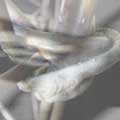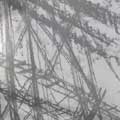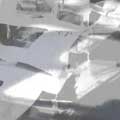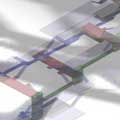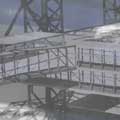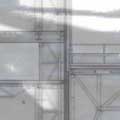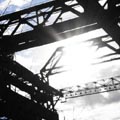Submarine
Design and Fabrication Facility.
Fore River Shipyard,
Quincy, MA
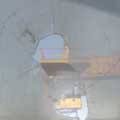
Arriving
at the abandoned Fore River Shipyard I was overcome by the sheer immensity
of its spaces. The weathered patina of shipyard’s history is palpable
in the cracked, crumbling, corroded texture of its massive steel structures.
The vast, silent, semi-enclosed spaces seem to house the ghosts of the
Herculean projects of industrial production that once took place there.
Trussed arches 150 feet high are buttressed and aligned so as to form
three distinct outdoor rooms, each containing an open volume of air hovering
above discrete slices of sea. These volumes are textured both by slashing
shadows produced by the sharp contrast between the open sky and the overlapping
depths of open steelwork and by gently disturbed reflections which arise
languidly from the partially confined sea. At its busiest, these massive
open frames housed thirty thousand workers who assembled a new battleship
every two months. Today only the latent characteristics of the site remain;
brute structures designed solely for utility bear silent witness to their
own obsolescence. They have become a landscape of memory, of activity
absent. This is the place for which I was to propose a new building to
serve the needs of a radically changed economy.
Once this site housed the production of battleships and oil tankers; today
it is to house the production of automated underwater vehicles (AUV’s):
robotic mini-submarines used for precise surveying of underwater terrain.
The buyers are the same: oil companies and the navy, but the techniques
of production, the scale of the enterprise, and the skills of the workers
have changed drastically. The design problem for me was: how to express
this shift in production needs while respecting the undertakings of the
past which have left their indelible markings on the site? I addressed
this problem with the two basic devices of open spacing and captured reflections
and a general organizing notion of the interdependent nature of the new
building and its existing context.
The new building is loosely contained by one of the three outdoor rooms
defined by the existing truss structure. It sits low in the space and
towards the sea; allowing room above for a semi-enclosed sky, it cascades
down to brush the sea and the existing docks which bound it. The new building
is composed of inhabitable trusses wrapped in glazing of various degrees
of transparency. These discreetly massed enclosures inhabit this space
as if they are being assembled there, organizing themselves around open
centers and spreading out like a canopy. Large elevator rooms which move
vertically in the center of the open space sketched out by the building
reinforce this notion of assembly: their shifting volumes open and close
substantial gaps in the building mass. The building is tenuously positioned
in this outdoor room, barely touching its boundaries and yet allowing
the physical forces of the existing structure to secure its form. While
the lower masses of the building hover just above the water extending
piers to submerged foundations, the upper masses float in the middle of
the space, draped by cables from the trusses which define the outer ceiling.
The building’s edges slide past the existing truss piers in close
proximity; at ground level they barely contact the edge of the dock to
allow access to the interior space of the building.
From the interior the discreet masses and open spacing define a notion
of community for the scientists and technicians who will design and fabricate
the AUV’s there. Laboratories and workshops occupy most of the lower
volumes of the building, defining separate work areas while overlapping
vertically to allow for visual and physical connections between the various
spheres of related activity. The upper part of the building houses offices
in perpendicular bars, organized along opposing ramps which define separate
regions while also allowing for spatial continuity. Together the volumes
of the building encircle open exterior spaces, defining the interior of
the building as an exterior which is interior to the surrounding truss.
Throughout the building there is a sense of trajectories shifting according
to defined parameters: sharp verticals, gradual slopes, and long horizontals
articulate one’s movement through the interior of the building and,
by extension, through space bounded by the surrounding truss. Thus, the
inhabitation of the building is characterized by an acute sense of inside
and outside, which extends both literally and analogically to a notion
of present and past. The shadows and reflections of both the existing
exterior trusses and the new interior trusses are projected onto the glazed
facade of the new building, serving as an ethereal intermediary which
articulates this conjunction of a new use and its historic context. While
this new building offers no distinct image of past use being overwritten
by present circumstances, it offers an experience of inhabiting the spaces
left vacant by history.
